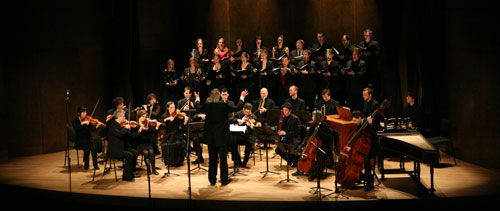Bach Meets Shostakovich: an Unfamiliar Rendition of a Familiar Masterwork by David Henkelman
/ September 1, 2012
Version française...
Flash version here.

Ensemble Caprice. Photo Ragnar Müller Wille
For Matthias Maute, musical director of Ensemble Caprice, the Brandenburg Concertos are the Mount Everest of 18th-century instrumental music. The concertos are daunting because they are a monumental work, a set of six sublime concertos scored for unusual groupings of instruments that, for many, symbolise the summit of the baroque concerto. They are also daunting for their apparent ubiquity: aside from Vivaldi’s Four Seasons, the Brandenburgs are arguably the most recorded set of concertos from any musical era. But when the classical music label Analekta suggested that Ensemble Caprice undertake the challenge of recording them, Maute was thrilled. “They were very strongly advising us to do the Brandenburgs,” says Maute. “It was great. It was like Christmas.”
However, when recording the most famous set of Bach’s concertos, ensembles are necessarily confronted with the challenge of attempting to present the concertos in an engaging way, elaborating upon the myriad of preexisting recordings rather than merely imitating them. The solution proposed by Ensemble Caprice was innovative: to punctuate each concerto with a transcribed prelude or fugue by 20th-century composer Dmitri Shostakovich, performed on Baroque period instruments. In so doing, not only are the concertos presented in an unusual way—they point to a paradox that is perhaps unintentionally perpetuated by the period performance movement: that the trend of focusing exclusively on a given musical era contradicts the historical situation of composers of such eras in the first place. “It’s against the nature of what must have been back then,” says Maute. “You had to really catch up with new ideas, play the newest music, play with what was really refreshing and revolutionary. So I think we have a biased way to deal with music from the past.”
The project forces listeners to question their own assumptions of how to perform period music. Maute expresses an acute awareness of the importance of keeping a new direction for performance practice in mind: “This ‘revolution’ [i.e. the period performance movement] has become standard in a way. Now we have to find new answers to the same old questions so as to allow us to refresh the music. And for me, personally, it’s not enough to just look back.”
To this end, Ensemble Caprice’s presentation of the Brandenburg Concertos makes effective use of fast tempi. “For me, it’s important to have a tempo that corresponds with what I feel, and that creates the strongest connection to myself,” says Maute. Furthermore, he insists that many of the recordings of the Brandenburg Concertos do not acknowledge the alla breve indications. As a result, movements such as the first movement of the third concerto, and the last movement of the fourth, are often played too slowly. Maute asks, “If you look at the score, it’s an alla breve indication. Why the heck would I not do what’s written?”
In addition to the lively tempi, the ensemble makes colourful use of dynamics. According to Maute, rhetorical principles and repeating motifs feature extensively in Bach’s music. One method of varying such motifs is the use of dynamics: “These rhetorical figures are meant to express a very clear idea and concept, and I think that every rhetorical figure has an inherent dynamic that comes with it,” he explains. For instance, the opening theme in the first movement of the third Brandenburg Concerto makes vivid use of dynamic range. “You get a dialogue within one line,” says Maute. As a result, he argues that the concertos acquire a greater sense of depth: “It is like a picture with three dimensions. And I think this is exactly what happened in the visual arts when they discovered perspective: that corresponds to dynamics in music.”
As for the future of performance practice, Maute expressed the need for musicians to experiment with different approaches. “We need to find something new,” urges Maute. “And what it is exactly is impossible to pinpoint right away.” Despite such anxieties regarding the directionality of the period performance movement (or perhaps because of them), the endeavour of Ensemble Caprice is essentially a poetic one: to create connections and underscore commonalities where previously there appeared to be none. It is an approach that some may embrace, while others may disparage. In all cases, it will provoke a reaction, and at creating “something new,” the ensemble has succeeded admirably.
www.ensemblecaprice.com
Bach Brandenburg Concertos/Shostakovich Preludes from Op. 87
Ensemble Caprice/Matthias Maute
Analekta

Ensemble Caprice has found an innovative and thought-provoking way to present Bach’s Brandenburg Concertos by juxtaposing the work of Shostakovich alongside that of the baroque master. Shostakovich shines unexpectedly on period instruments. The alluring, ethereal harmonies are accentuated, and imitation between the voices and the layering of different melodic lines become wonderfully apparent. This appreciation carries over to movements of the Brandenburg Concertos, for instance during the first movement of the second concerto, with the recorder, violin, oboe, and trumpet in a dazzling, crisp exchange of musical themes. One should bear in mind, however, the caveat that the tempi are unusually lively. While some listeners may find the playing excessively fast, the tempi decisions gradually become acceptable to the listener’s ear, thus allowing other aspects of Bach’s music, such as the dynamic range and the overarching musical structure, to become more apparent. Listening to this recording requires an open mind. Ensemble Caprice challenges our assumptions of how these sublime concertos should be performed, and once past the jarring differences with previous renditions, the listener will undoubtedly find something—more likely several things—to appreciate in this rich recording.
Version française... |
|


